Shipping laundry detergent requires careful planning and determination from a variety of factors. If you need help with wholesale laundry detergent shipping, working with a shipping company that has the correct knowledge and experience is a must. Laundry detergent is considered to be a hazardous material. When shipping laundry detergent, it needs to conform to the regulations of a number of different organizations. The complications and intricacies of shipping laundry detergent in large amounts are essential to carrying out the work responsibly and efficiently. An expert shipping company will help you to understand everything, from the correct packaging to the paperwork that needs to be completed.
Getting assistance with laundry detergent shipping will ensure you don't miss any of the rules and regulations. Your shipping company can help you with the requirements and guidelines laid out by organizations such as the Department of Transportation (DOT). You can quickly and affordably get your wholesale laundry detergent to its destination with the right logistics company.
Get started with laundry detergent shipping with this guide, which will answer some of the key questions surrounding shipping detergent. Understand what is classed as laundry detergent, how its transport is controlled and how to ship it safely and efficiently.
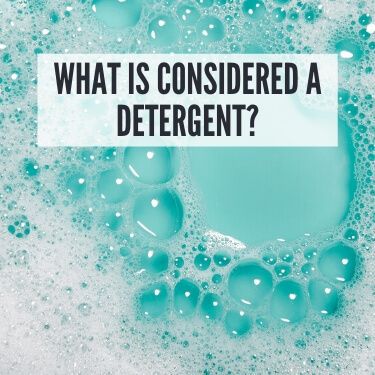
A detergent is a product with cleaning properties that is water-soluble. It is a surfactant - a compound that lowers the surface tension between two liquids, a gas and a liquid, or a liquid and a solid - or a mix of more than one surfactant. While the word 'detergent' usually refers to laundry detergent or dish detergent in a domestic context, it can also refer to other cleaning solutions. When it comes to shipping laundry detergent, it may be less important whether a product is considered a detergent and more important to consider its composition, ingredients and whether it fits into any dangerous goods hazard classes. For example, some detergents might be flammable liquids.
Detergents are like soaps. However they are usually more soluble in hard water. This is due to the fact that sulfonate does not easily bind calcium and other hard ions. In chemistry, detergents have different types of electronic charge, which are anionic, cationic, or non-ionic. As well as being used for cleaning, they are also fuel additives and biological reagents. As the name makes clear, a laundry detergent is any detergent that is used for washing clothes and other laundry. If shipping laundry detergents internationally, it might also be necessary to consider how other countries and their relevant official bodies define a detergent.
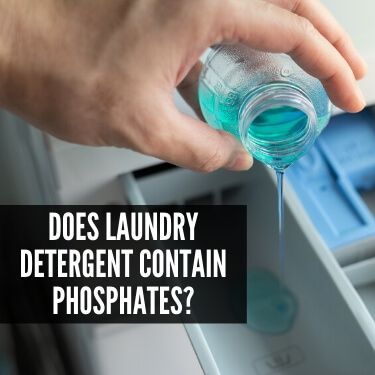
Phosphates are a naturally-occurring form of phosphorus, which are used in many cleaning products. They are used as an ingredient in cleaning products, including detergents because they help to soften hard water and suspend dirt. However, phosphates are also controversial due to the fact that they are also considered to be a pollutant. Phosphates are difficult to break down by ordinary wastewater processing systems and are carried into natural water sauces. They encourage the growth of algae and reduce oxygen levels in the water needed for aquatic life.
Laundry detergents contain phosphates in the past in varying levels. However, a nationwide voluntary ban of phosphates in laundry detergents began in the U.S. in 1994. In 2010, some states also extended this to dishwasher detergents. The conversation surrounding the ban started due to pollution of the Great Lakes, which prompted discussion and protest in the 1960s. By the 1970s, some states were already choosing to ban phosphates in laundry detergents. Some other countries have also introduced regulation regarding phosphates in detergents, and the European Union requires detergents to be biodegradable.
When dealing with laundry detergents in the U.S., they should not contain phosphates. However, you may have to consider that laundry detergents manufactured outside of the U.S. could contain phosphates. It is also worth keeping in mind that other detergents, such as dishwashing detergents, may still contain phosphates in most states.
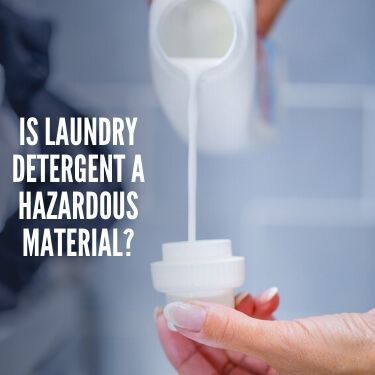
It's important to know whether something is a hazardous material before handling and shipping it. If you want to ship hazardous materials, there are certain rules you will need to follow concerning handling, packaging and transportation. Laundry detergent is considered to be a hazardous material by several relevant organizations, including the Department of Transportation. However, it's not as simple as whether laundry detergent is or isn't a hazardous material. There are different categorizations that influence the precautions that must be taken when shipping hazardous materials. Which category a laundry detergent belongs to will depend on the ingredients and whether they have any particular properties or dangers.
The different classes of hazardous materials or dangerous goods include:
The category that a laundry detergent might belong to will depend on its composition. Some detergents may contain corrosive substances due to containing ingredients such as sodium hydroxide and bleach. Most laundry detergents are also harmful to swallow or inhale.
The specific hazards relating to any laundry detergent product need to be identified on OSHA Safety Data Sheets for shipping. These will outline the product's chemical composition and the various hazards that they might or might not pose. They cover matters such as first aid and fire fighting information, as well as handling and storage precautions and regulatory information. When buying wholesale laundry detergent from a manufacturer, they will provide Safety Data Sheets.
It is important to identify the specific hazards that a laundry detergent might present so that the regulations set out by the Department of Transportation and other bodies can be followed. Identifying hazardous materials during shipment protects anyone who might be handling them during transit, including warehouse staff, truck drivers, or anyone unloading or loading the products. It also helps to ensure that the right precautions are taken to keep the goods safe and stable while they are being transported.
However, not all laundry detergents meet the official definition of hazardous substances. Although all laundry detergents are likely to present at least a low-level health hazard, particularly if swallowed, inhaled or if they make contact with the eyes, some will require fewer precautions for handling, storage and transport. The most important thing to do is understand what is in a laundry detergent and ensure any hazards are identified.
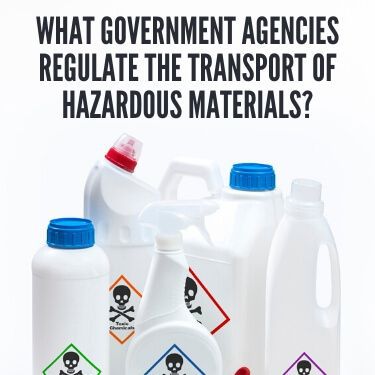
When shipping wholesale laundry detergent in North America, it is necessary to understand which government agencies regulate its transport. Each agency may have different requirements for packaging, labeling and transportation. Some key agencies that regulate the transport of hazardous materials include OSHA (Occupational Safety and Health Administration), the EPA (Environmental Protection Agency), the DOT (Department for Transportation), and the NRC (Nuclear Regulatory Commission). Keep reading to find out how each agency plays a role.
The Occupational Safety and Health Administration (OSHA) is part of the Department of Labor. It is responsible for ensuring safe and healthy working conditions for workers throughout the country. In relation to the shipping of hazardous goods, OSHA helps to make sure that any workers handling items such as laundry detergents are aware of any hazards and how to safely handle the goods and that they are protected from potential hazards.
One way that OSHA affects the shipping of hazardous materials is through the Hazard Communication Standard. This was revised in 2012 and Safety Data Sheets are now required for any hazardous material. The sheets follow a 16-section format to help familiarize workers with the contents of SDSs.
When it comes to the transportation of hazardous materials, OSHA has limited jurisdiction of over-the-road transport. If there is a spill while the material is traveling or on a vehicle, OSHA's HAZWOPER standard applies. It helps to protect emergency response personnel responding to the spill. However, there are relevant OSHA standards for both compliance and training. These include 1910.120, Hazardous waste operations and emergency response, and 1910.134, Respiratory protection.
The Hazardous Materials Transportation Act is one of eight laws defining the EPA's Emergency Management Program. The main objective of the HMTA is to protect life, property, and the environment from the risks that come with transporting hazardous materials. A hazardous material is defined by the Secretary of Transportation. It is a material that can present an "unreasonable risk to health, safety and property during transportation in commerce."
The Environmental Protection Agency designates hazardous wastes and substances in the U.S. Hazardous substances are designated by two other laws in the Emergency Management Program, the Clean Water Act (CWA) and the Comprehensive Environmental Response, Compensation, and Liability Act (CERCLA), while hazardous waste is designated by the Resource Conservation and Recovery Act. The HMTA is responsible for regulating all essential modes of transport, including those over land, sea, and air.
Regulations under the HMTA are categorized as four key provisions:
The Act applies to anyone involved in transporting hazardous materials, including those who cause hazardous materials to be transported. However, it is the person who offers the shipment containing hazardous materials who has most of the responsibility. It is the responsibility of carriers to make the required information available to anyone responding to an incident or carrying out a hazardous materials investigation.
The HMTA is also enforced by other agencies, including agencies for specific forms of transport and different types of materials. They range from the Federal Highway Administration to OSHA and the Department of Transportation.
The Department of Transportation takes care of checking the test conditions of packages. This is the role they play in carrying out the Hazardous Materials Transportation Act. They are less involved in the transportation conditions of materials. Their enforcement includes carrying out random packaging inspections in facilities where transport passes through, such as freight terminals and airports to check compliance regarding marking and labeling of packages. The DOT also covers manufacturing and testing facilities. They might also check the shipper's facilities if manufacturing takes place there.
Hazardous materials are to be properly classified and packaged to follow DOT regulations. They also need the correct labels and they need to be handled correctly and stored safely. It is your responsibility, according to the Department of Transportation, to know whether the materials that you are shipping are hazardous. Their Getting Started with Shipping Hazmat guide is a good resource to ensure you know what the DOT requires. Their advice includes checking the Safety Data Sheets and the Hazardous Materials Table, as well as preparing the hazard communication and shipping paper correctly. To ensure you are complying with all of the regulations relevant to the Department of Transportation, take extra care when preparing any packages to ship.
The Nuclear Regulatory Commission is another government agency that is concerned with the regulation of transporting hazardous materials. However, its task is to protect public health and safety related to nuclear energy. If you are transporting laundry detergent, this agency is unlikely to concern you. The agency oversees reactor safety and security, licensing, radionuclide safety, and the storage, security, recycling, and disposal of spent fuel. The regulatory mission of the NRC covers reactors, materials, and waste, particularly the transportation of waste.
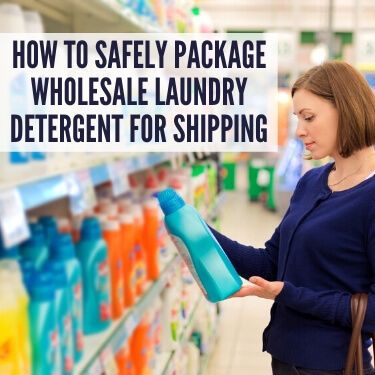
Laundry detergent must be properly packaged before it can be shipped safely. There are two packaging elements to consider for laundry detergent. Firstly, there is the packaging that holds individual volumes of laundry detergent for selling, then there is the packaging that will hold these during shipment. Laundry detergent might be packaged in a number of ways, including in bottles, bags in boxes, pouches and more. These could then be placed into boxes, crates, pallets, or other packaging for shipment.
The primary concern is preventing leakage when transporting liquids to avoid exposure to anyone handling the laundry detergent. Although most laundry detergents might only be a mild irritant during a spill, it's still important to protect people. Even without the hazards that laundry detergent can present, a spillage is going to be costly and time-consuming to clean up. It pays to avoid making a mess by packaging your laundry detergent properly. Some of the tools that can help to make packaging safer include double seals on bottles and secondary waterproof bags, boxes, or crates.
Hazardous materials need to have packaging that is "sufficient to ensure containment of the material throughout the entire transportation cycle." Transport by air generally has stricter requirements than transporting hazardous materials by land. Most hazardous materials need to be shipped in performance packaging that meets requirements both inside and out. This type of packaging needs to be tested to ensure it meets regulations. Each material on the U.S. chemical table has an associated packaging authorization reference. DOT Special Permit packaging might need to be used for some hazardous materials.
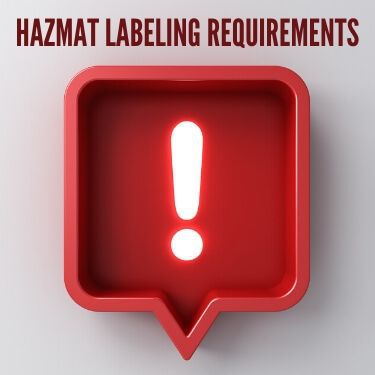
Shippers are responsible for ensuring their hazardous material shipments are appropriately labeled. They must include a hazard warning label and display other information, such as a proper shipping name, a classification and an identification number.
There are various requirements for labels, as well as their placement. The regulations concern the durability, size, shape, color, design, and identification information on the label. The EPA and DOT are responsible for labeling requirements under 49 CFR part 172.407 subpart E.
The requirements include:
The packaging needs to survive 30 days of exposure to typical transport conditions. Temperature, moisture levels, and precipitation are taken into account. There should be no deterioration or noticeable change in color.
The labels need to be printed so the inner border and symbol are exactly the same on each label. They need to comply with the rules in 49 CFR 172.411 through 172.448.
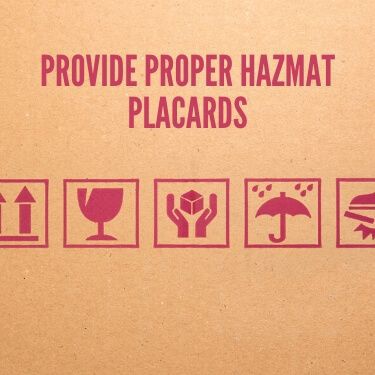
The responsibility of providing proper hazmat placards falls on the shipper and not on the carrier. If you need hazmat labeling when shipping laundry detergent, you will need to make sure that you source and provide the correct placards to the shipping provider before your shipment is ready to go out.
Although hazmat labels and placards are similar, there is a difference between them. Hazmat labels go on the packages themselves, identifying what is inside. However, hazmat placards are placed on the mode of transport being used, such as a truck or other vehicle, as well as cylinders and outer containers. They are large and durable, designed to clearly communicate the presence of hazardous materials while they are in transit. As well as being useful for anyone transporting or handling the hazardous materials, they are essential for emergency responders. In the case of an accident or incident, the placards act as warnings for first responders.
The placards that accompany your shipment must have one of the nine hazmat categories on them. This is another important reason to make sure you know which category, if any, your laundry detergent belongs to. The DOT 49 CFR 172.504(a) says that placards are required in several locations. They need to be displayed on freight containers, bulk packagings, and transport vehicles. Placards are also needed for railcars and unit load devices. Placards need to be placed on each side and each end of the packaging, vehicle or car. An exception is when it is coupled with another rail car or vehicle.
The use of hazardous materials placards is required by law and regulated by the Department of Transportation. As the shipper, it is your responsibility to supply them to the carrier and ensure that they are used. Failure to comply with the regulations could result in large fines and other consequences.
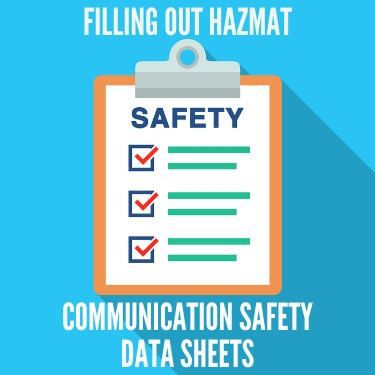
Manufacturers, distributors, and importers need to provide Safety Data Sheets for each hazardous material in accordance with the Hazard Communication Standard (HCS) (29 CFR 1910.1200(g)). This is to communicate information on hazards to everyone handling hazardous materials. Safety Data Sheets were previously Material Safety Data Sheets (MSDSs), and SDSs are largely the same, but with a new 16-section format. This format helps to standardize information and make it easier for workers handling hazardous materials to become familiar with the format and contents.
Sections 1-8:
Sections 9-11 and section 16:
Sections 12-15
The sections on the Safety Data Sheet are:
If you are not the original manufacturer of the laundry detergent that you are shipping, you should already have the relevant information about your product from the manufacturer.
When you are looking for a shipping service for hazardous materials such as laundry detergent, it's understandable that you want to take your time. Finding the right service isn't something that you want to rush into if you want to be sure that everything is done correctly. While much of the responsibility for the correct packaging and labeling of hazardous materials falls on you, you also need a shipping service that will help to make everything easier. Shippers need to work with you on getting everything right and be willing to cooperate to ensure everything follows regulations.
It's important that the company's employees have received the correct training in handling and transporting hazardous materials. Some companies can even provide you with assistance for filling out your paperwork and ensuring you have everything that you need to ship hazardous materials. Identifying a shipping company that knows what it's doing doesn't have to be difficult. When you are looking for the right service, be sure to check a company's information about how they handle hazardous materials. Different carriers can have different rules and procedures. Of course, they can also provide plenty of useful information to help you out.
Another thing that you might want to consider is the extent of the services offered by the company. Some shipping companies are able to help you to gain better control of your supply chain and logistics to improve your business. Supply chain consultants, a network of partners, and multiple locations are some things that you might look for.
Look for a shipping partner with experience in handling hazardous materials and well-trained staff. If the company has knowledge of your industry and of handling chemicals of various types, they will be able to offer you a comprehensive and reliable service.
If you are looking for the right partner for wholesale laundry detergent shipping, team up with R+L Global Logistics to ensure the best results. Our experienced team will do everything that they can to make it easier to ship laundry detergent and keep your supply chain operating smoothly. We have experience in the chemical industry, as well as in transporting consumer goods. We are knowledgeable about transporting hazardous materials and can provide you with the tools that you need to transport your detergent products safely. Our team has trained domestic ground and international certified employees who can make sure that cargo and documentation are handled safely.
R+L Global Logistics offers a range of domestic and international shipping services, including truckload, refrigerated shipping and expedited freight. We also provide global logistics, including supply chain management and warehousing, to take care of any other needs that you may have. As a leading provider of logistics and supply chain services, we can make shipping your wholesale laundry detergent more simply, without compromising on safety or efficiency. We work with you to meet your needs so that you can compete in the global marketplace and ensure efficiency and top performance for your company. We have you covered whether you are doing shipping in Florida, Ohio or have more specific routes in mind like shipping from Michigan to Texas.
To get started with wholesale laundry detergent shipping with R+L Global Logistics, take a look at our services and other information to find out more about what we can offer you. We can even help you with very specific topics like: How are bell peppers transported? You can find case studies and further evidence of how we can help it easier for you to ship hazardous materials such as laundry detergent. Click on "get a quote" to start the process of requesting a quote for your shipment or get in touch with us if you have any questions or want to discuss your requirements. Check out our tools and resources, too, for valuable information about shipping your goods. Call us at (866) 353-7178 for a free quote today.
R+L Global Logistics
315 NE 14th St., Ocala, FL 34470